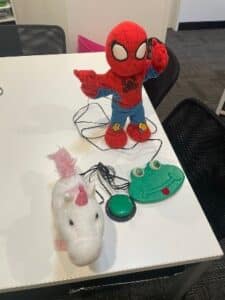
Cerebral Palsy Alliance Port Macquarie Therapy Manager Alex Wilson mentored students from a local primary school to design accessible clothing, which was showcased at the STEM Make a Difference (MAD) design conference in Melbourne.
Alex and his wife Ellie recently moved to Port Macquarie for a sea change experience and have been immersing themselves in the community. Ellie works at the local Primary School, where her students were participating in STEM Make A Difference (MAD), a national competition to create a prototype of a product that will make a difference in someone’s life.
When Alex heard about the STEM project, he jumped at the chance to mentor them, keen to share his knowledge of Assistive Technology and how it benefits people with disabilities.
Alex, along with Occupational Therapist student Breana Stevens-Hofer, visited the students at St Joseph’s Primary School and demonstrated the range of Assistive Technology used by clients in therapy and everyday life; to improve access to play, communication, mobility and independence, including:
Used for play, learning transferrable skills, and social participation, switch adapted toys are toys that have been modified so the original switches are rerouted to a larger or easier-to-use switch that is accessible and easy to operate depending on an individual’s particular challenges or goals. The new switch may be a finger switch, foot switch or button switch of varying size and material using preferred movements and textures.

Switch toy example (above)
Magic Carpet is an inclusive play environment which projects interactive games and images onto the floor that users can play with and control simply by moving on or over the projected image. This multisensory game helps to make therapy and learning fun.

Students in action playing with the Magic Carpet Assistive Tech (above)
Eye-gaze control technology can be used by children and adults who have significant physical disabilities to be more independent. Eye-gaze control technology can provide opportunities to operate a TV, telephone and music through remote control.
The way it works is that an eye-gaze camera tracks the person’s eye movements, which then moves the mouse on a computer screen. The person selects items either by holding their eye-gaze for a certain time, by blinking, or by clicking an external button.

Example of eye gaze control technology featuring CPA client (above)
The students were initially keen on making accessible games or video games, but as they learned more about the challenges people with disabilities faced they decided to focus on adaptive clothing. The reason being they understood that young people with disabilities love clothes, and want to feel comfortable and good in what they wear, and not stand out in clothing that’s obviously adapted for people with disabilities.
“The students had many design ideas, I helped to give them the big picture, to problem solve and refine their designs. It was a wonderful opportunity for me to give back to the community, help to raise awareness of disability, inclusion, and the importance of Assistive Technology,” said Alex.

The students were thrilled to be selected to represent the Lismore Diocese in Melbourne to showcase their STEM Make a Difference (MAD) design at the National Catholic Education Conference.
“We’re very grateful to CPA for the support that they gave the school and my students on this project. It certainly piques their interest in STEM, I hope that this experience will help to springboard some of them into a life working in STEM”, said Ellie.